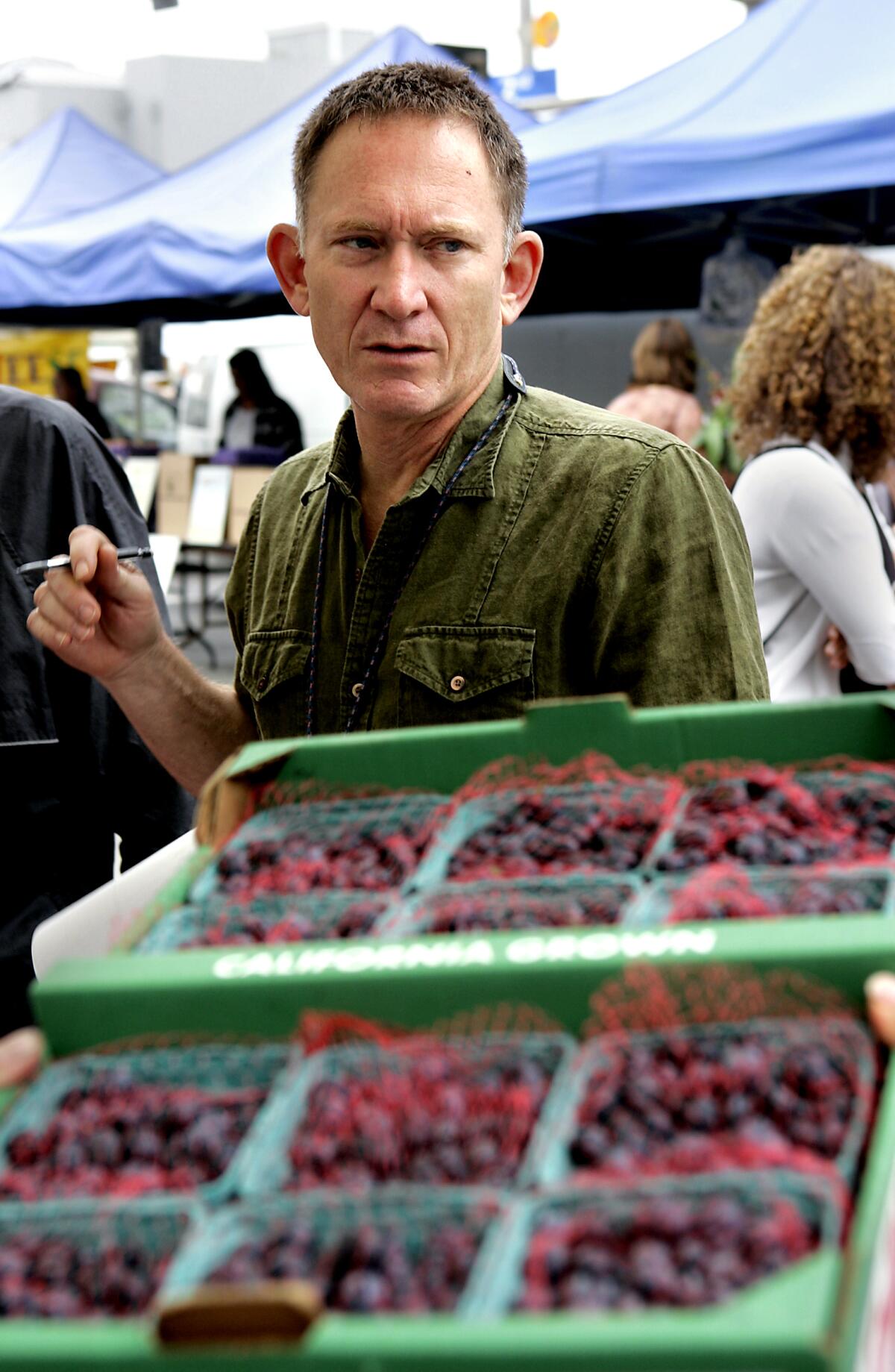Mark Peel helped codify the notion of American ‘urban rustic’ cooking

If you whittle down the list of restaurants that shaped modern Los Angeles dining culture — the places where the now-stereotypes of California cooking were once fresh revelations, from which influences continue to ripple even if younger generations have no knowledge of their origins — Campanile would hover in the top five, maybe even the top three.
Mark Peel, who died Sunday, and his then-wife, Nancy Silverton, opened the restaurant in 1989 at 624 S. La Brea Ave., in an arched, ornamental Spanish Colonial Revival set piece of a structure built by Charlie Chaplin in 1929. Until they split in 2005, they were viewed by the world as the first couple of the nation’s emergent California-Mediterranean restaurant ethos.
Both chefs had worked for Wolfgang Puck during his ascendance with Spago. They helped him tease out his wild, New West vision of food as a grab bag of fusion flavors and the kitchen as a playground of ideas. For their own restaurant, though, they moved in the opposite direction of smoked salmon pizza and lobster spring rolls. Peel had cooked at Chez Panisse, and he drove the farm connection at Campanile literally, at first hauling produce himself from Chino Farms in Rancho Santa Fe, two hours south of the restaurant. With his mastery of the grill and Silverton’s wondrous bread-baking and pastry programs, the pair codified the notion of American “urban rustic” cooking.
I had my first meal in Los Angeles at Campanile. It was spring 1997. I was 24 and worked at a restaurant in Seattle, making desserts and cooking brunch on weekends. My best friend, Kazzie, was trying to make it as an actor in L.A. I flew down to see her, and our dinner plans — straight from the airport— were a long-awaited, foregone conclusion. Kazzie had been to the restaurant’s famous adjunct La Brea Bakery but never to Campanile — an experience we’d both been saving up for.
Memories of that night will sound like clichés now: The startling, direct earthiness of fava purée enriched with good olive oil and lightened with lemon, the smoke that clung to swordfish seared with inky grill marks. I’d ordered it in the hopes of tasting swordfish that wasn’t overcooked, as it was in basically every restaurant in those days, and my risk was rewarded. Kazzie’s entree was a crisp flattened chicken with a garlicky parsley salad, a menu staple. The dish wasn’t as austere as it sounded: Peel dressed it in a sauce he called “beurre fondue.”
Mark Peel helped introduce countless Los Angeles diners to farm-to-table dining.
We asked for every dessert. I best remember a galette of both fresh and dried cherries. Vanilla bean and balsamic vinegar flavored the filling, and the ways their taut contrast complemented the fruit stretched my brain as a young cook.
As baseline and even old-fashioned as the meal sounds, few chefs, then or now, really pull off the simple-yet-profound style of cooking with consistency and abject deliciousness. Campanile did. Legends of Los Angeles food criticism — Ruth Reichl, Jonathan Gold, S. Irene Virbila — all pointed out the restaurant as a place they loved so dearly that they were as much regulars as professional reviewers can be.
After Silverton and Peel divorced, Silverton left to start the third act of her blockbuster career with Osteria Mozza and Pizzeria Mozza. Peel continued running Campanile until it closed in 2012 (Silverton’s father was the landlord) and was rechristened as République by Walter and Margarita Manzke.
Peel’s influence lives on in the chefs who passed through his kitchen, many whose names remain well-known in Los Angeles: Suzanne Goin of A.O.C., Matt Molina of Hippo (previously executive chef of Mozza), Bryant Ng of Cassia and Suzanne Tracht of Jar are among them.
Peel never opened another restaurant with the seismic impact of Campanile, but he found a way to remain in the center of Los Angeles’ evolving culinary identity: For the final act of his career he ran Prawn Coastal Casual, a stall specializing in fried seafood baskets and shrimp salads, in Grand Central Market, among the vendors selling pupusas, galbi, bentos, tacos, adobo bowls and rigorously seasonal fruit pies.
His legacy also continues in subtler ways. In 1998, four years before I became a restaurant critic, a book called “Dining Out,” written by Andrew Dornenburg and Karen Page, was published. It details the history of American restaurant criticism and contains dozens of interviews with writers, chefs and other figures the authors call the “food intelligencia.” As someone working in restaurants who wanted to write about them, I read the book over and over.
An interview with Peel on Pages 112 and 113 has stayed with me for nearly 25 years. It’s framed in a box with the title “Is the Customer Always Right?” Peel tells the story of putting a pulled-chicken sandwich on the lunch menu at Campanile that was tossed with aioli and served with bacon. L.A. being L.A., customers right away requested the sandwich minus aioli and bacon — and then complained about it being awful. Peel urged the servers to gently steer customers to other choices if they didn’t want those elements in their lunch, which led to one diner yelling obscenities at the staff, indignant over the idea that a chef’s aesthetic might take precedence over the wishes of a customer.
Peel details his reasoned response: “We are not trying to force you to eat something you don’t want; we are trying to offer you something that will make you happy and is the best we can do.” He finishes with this sentiment: “You have to make your customers happy, or you are not going to stay in business. But on the other hand, I think there comes a point where you have a duty to your staff to support them when a customer is clearly wrong.”
This can still be a touchy subject, the sometimes uneasy symbiosis among chef, wait staff and diner. But at a time when the COVID-19 pandemic revealed the fragility of the restaurant industry and many operators are struggling to restaff and think through how to support their employees, Peel’s honesty (his admissions were nervy by 1998 standards) has a relevance that transcends generations and platitudes.
More to Read
Eat your way across L.A.
Get our weekly Tasting Notes newsletter for reviews, news and more.
You may occasionally receive promotional content from the Los Angeles Times.











